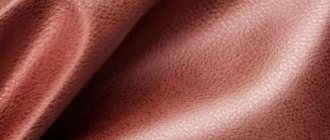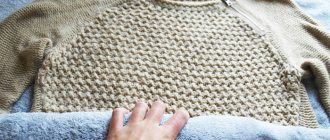Acrylic is a synthetic material. Acrylic fiber has great strength and dyes well. During washing, the paint is not washed out of it, thanks to which such products retain their color for a long time. They are wear-resistant, not susceptible to mold, not damaged by moths, and do not wrinkle.
At the same time, there are a number of disadvantages that should be taken into account during operation and washing:
- acrylic fabrics do not absorb moisture well;
- easily form greasy stains;
- During washing, the item may become deformed, stretched, or form pills.
Therefore, many people believe that machine washing of these products is impossible. Actually this is not true. To avoid negative consequences and not spoil the item, you need to apply certain rules and know how to wash acrylic.
Handwash
Hand washing is preferable for acrylic items. But how to wash an acrylic sweater, since it is a heavy garment to wash by hand. If stains have formed on the product, they should be washed separately, and immediately while they are fresh, preventing them from “eating” into the clothes. Any detergent will work for this, even dishwashing detergent.
As with machine washing, the item should first be soaked in a soapy solution with a water temperature of no more than 30°C, the time depends on the soiling - from 10 minutes to 1 hour.
Among the detergents suitable are gels and powders for special purposes for artificial fabrics. It is good to use baby or white laundry soap. For better dissolution in water, they need to be grated into shavings on a coarse grater.
We recommend:
How to wash a wool coat in a washing machine
After soaking, dirty water must be carefully drained. Make a new soap solution and wash it, lightly squeezing it with your hands. The sweater requires more careful attention, and in order to prevent deformation, there is no need to use force and friction. However, these recommendations are relevant for all acrylic products.
You need to rinse the sweater in cool water, changing it in the basin several times. You should not take it out of the water or lift it from the container, just drain the water while holding the sweater with your hand. Add conditioner-rinse aid for synthetics or 9% vinegar to the last portion of water. This will remove the remaining soap, the fabric will become soft and pleasant to wear, and will not electrify.
The spinning process is that the product is not twisted, but slightly pressed to the bottom of an inclined container, allowing the water to drain. The raw product must be wrapped in a dry cloth that will absorb any remaining moisture. All of these hand washing tips apply to any acrylic garment.
Removing contaminants
But, before you start washing the product in powder, you need to carefully inspect it for stains, and, if any are found, remove them. To do this, soak the clothes in cold water and then remove the stain. Fresh stains are much easier to remove, so it’s better not to delay removing stains.
You can remove stains from acrylic thread with regular brown washing soap. To do this, lather the stained area thickly, leave the item for half an hour, and then gently rub the stain with your hands.
How to wash scarves made from different materials
A scarf can be made from various fabrics, so it is important to provide the product with proper care. There are scarves made from linen or cotton, chiffon or viscose, cashmere or wool, combined linen or jacquard. Drawings, prints, metal and fur details can be used as decoration for the accessory.
You can wash the scarf by hand or in the washing machine. It is better to dry clean a heavily soiled item or one made from very delicate fabric.
If you cannot decide on how to wash your scarf, then it is recommended to use the manual method, as it will allow you to wash the item carefully.
It is not recommended to twist or wring out scarves to avoid the problem of the product losing its shape.
The scarf should be washed in an automatic washing machine on the delicate cycle.
Does acrylic shrink after washing?
When washing and drying acrylic items, stretching occurs more often. But you need to know whether acrylic shrinks after washing. There are times when acrylic clothing shrinks. This occurs when the temperature regime is violated, when the water heats up above 40°C.
If the entire product shrinks evenly, you can try to return it to its original size. To do this, soak the item in water with conditioner, without twisting, to remove excess moisture. To dry, you need to stretch the item, securing it on a surface covered with absorbent fabric. Throughout the drying period, stretch the product every half hour.
Note! If an item shrinks unevenly, it cannot be restored.
An acrylic hat with the addition of other fibers can be dried by stretching it over a 3-liter jar. Then it won’t shrink and lose its shape.
What are the benefits of acrylic and what are its disadvantages?
If you are interested in learning about how to properly wash acrylic, you will need some knowledge of its features:
- A fabric such as acrylic is quite soft and gentle to the touch.
- This material can dry fairly quickly after it has been wetted.
- It has a low level of hygroscopicity. It almost does not absorb moisture. This allows such things to hardly deteriorate after washing, but it also reduces the hygiene of the material.
- Clothing made from acrylic stretches and can roll down when worn.
- If acrylic is not properly cared for, its color may fade over time.
- This fabric is capable of absorbing fat.
- Acrylic does not like high temperatures. Hot water makes it rough, it loses its softness, and the thing loses its shape.
Features of stain removal
It is important to remove stains that appear immediately, before the dirt is absorbed into the fibers. This must be done before washing by soaking in warm water and soapy water. You can use either laundry soap, powder or gel. Shampoo is also suitable for greasy stains. The wet stain is lightly wiped and then left in water for no longer than 15 to 20 minutes. For very heavy stains, the soaking time can be extended to an hour. Only after this can the item be washed, followed by rinsing and drying.
What is absolutely forbidden to do?
It is important to remember that it is not recommended:
- Dry acrylic products on a central heating radiator. High temperatures will cause knitwear to shrink, and white items will also turn yellow.
- Throw the synthetic fabric over the clothesline and clamp it with clothespins. The rope and clamps will leave “eternal” marks. A thing, especially a voluminous one, will probably stretch out.
- Leave products in direct sunlight. Over time, white fabric will acquire a yellowish tint, and colored fabric will fade. Therefore, when drying outdoors, it is better to place things in the shade or cover them with a thin white cloth.
Synthetic knitwear cannot withstand high temperatures, so acrylic cannot be ironed even at minimum power.
As you can see, washing acrylic items is not at all difficult. However, if you ignore the described rules, they can quickly lose their presentable appearance.
photo: depositphotos.com/vlarub
Useful tips
Tips that all owners of knitted items should familiarize themselves with:
You can improve the quality of your wash using fabric softener.- Knitted items can be washed with other items, but they must match each other in color.
- When loading knitted items into the drum of a washing machine, take into account their weight. After getting wet, they become 3-4 times heavier.
- If the product has absorbed foreign odors, it is not necessary to resort to washing. It is enough to ventilate it in the fresh air for 12 hours.
- For washing light-colored fabrics, you can use gentle liquid stain removers and oxygen bleaches.
To fluff up small fluff that has rolled up after washing, you need to lay the dry product on a flat surface and go over it with a fine-toothed comb. If it gets stuck on the spools, there is no need to pull it. They are carefully cut with scissors or a special machine.
Drying and ironing
This procedure is the final stage of washing clothes made from acrylic thread. The final look of the outfit depends on it.
Drying has its own nuances:
- the product must be positioned horizontally;
- do not hang acrylic on ropes or heating radiators;
- It is recommended to place a thin cotton fabric under the product;
- Drying should be done naturally at room temperature.
Important: ironing synthetic items is strictly prohibited. This can only be done to correct tissue deformation.
Acrylic clothing has many benefits. And if you are ready to close your eyes to small nuances when washing products, then such things will become your favorite.
Is it possible?
You can wash knitted items either in a machine or by hand. However, there are a few points you need to pay attention to before you begin the procedure:
Determine the type of yarn. For natural wool, liquid detergents are used. They are washed using a special program. Synthetic knits can be processed as usual using powder.- Before you start washing, you need to read the information on the product label.
- Dosage the detergent according to the instructions, since a lot of foam is formed when washing knitted items.
- Wash items only when necessary. The less often knitted items come into contact with water, the better.
If you just need to refresh the fabric, resort to dry cleaning. The product is placed in a plastic bag, covered with soda and shaken thoroughly. After 15 minutes, all that remains is to shake and ventilate the item.
Advantages of acrylic items
Acrylic is a synthetic material that is an artificial substitute for wool. Polymer-based items provide excellent warmth, retain heat, and are much cheaper than clothing made from natural fabrics. Speaking about acrylic sweaters, it is worth noting that they:
- very soft and pleasant to the body;
- dry quickly after getting wet;
- not interested in moths and other pests;
- have high heat-saving properties;
- do not cause allergic reactions;
- With proper care, they retain their color brightness for a long time.
Acrylic fabrics also have disadvantages. Such clothes tend to stretch out and pills often appear on them. However, if you follow the rules of caring for acrylic items, they will delight their owner for a long time.
Interesting:
- How to properly wash woolen items?
- Is it possible to spin woolen items in the washing machine?
- Washing a sweater
- Washing knitted items in the washing machine
- How to wash a sweater in a washing machine
- Washing faux fur in the washing machine
Reader comments
- Share your opinion - leave a comment











